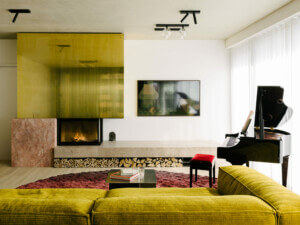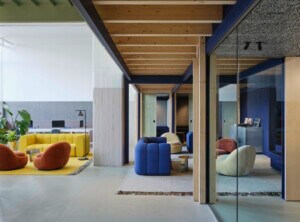The Danish-Icelandic artist Olafur Eliasson’s multi-story studio is located in an old 19th-century brewery in Berlin’s Prenzlauer Berg district. The combination artist’s studio, materials research laboratory, and fabrication workshop is outfitted with elegant Hans Wegner furniture, displays of Eliasson projects, artwork prototypes, and a glass-walled kitchen for employees’ daily lunches. Inside this calm, but busy, workshop there is now an architecture office.
Directed by Eliasson and architect Sebastian Behmann, Studio Other Spaces is a natural outgrowth of the large-scale public sculptures and installations that Studio Olafur Eliasson has been creating since the mid-1990s. Eliasson has long had an interest in architecture, running an art school called the Institute for Spatial Experiments and working for many years with Einar Thorsteinn, an architect and geometry expert who was a follower of Buckminster Fuller. Studio Olafur Eliasson was also part of the James Corner–Diller and Scofidio + Renfro design team for New York’s High Line park. For several years the art studio has had major clients commissioning projects that were really exterior curtain walls, like the Harpa Reykjavik Concert Hall, designed with Copenhagen-based firm Henning Larsen (and winner of the 2013 Mies van der Rohe Award), which has a facade of quartz-like hexagonal sections.
Eliasson writes that he believes the “culture sector in our society is more likely to create change than the public sector, the politicians, or the private sector.” This new architecture office is perhaps a vehicle to combine his dramatic public art with a pragmatic social program. This desire by designers and artists to also be architects has a long lineage going back to the Renaissance through the Vienna Secession, and today we see it with artists like James Wines of SITE or industrial designers like Pentagram and Thomas Heatherwick. Given all the requirements of building, it is still not common for an architect to be grounded in art, but with the capabilities of today’s digital practice and the range of large-scale public art, we may start to see more of these professional distinctions erode. Studio Other Spaces’ recent projects and its facility with spatial design shown here is not just branding, but sophisticated architecture.
Head of design in Studio Olafur Eliasson, Behmann is an educated and licensed architect and has been consulting on the studio’s architectural projects since 2001, though the studio only recently began to design major monuments all over the world. The architecture office currently has eight architects on staff, all with different backgrounds. Eliasson said he admires architects because “they build buildings for people who are not interested in buildings—they just work in them, or they just sleep in them, or they just eat in them.” This a very good start for practicing architecture.


Ilulissat Icefjord Park
Competition
The park design uses melting ice to shape space based on a unique design strategy where ice is at once the formwork of a concrete structure and the focal point of the resulting space. Icebergs were harvested directly from the nearby ice fjord to create an exhibition building, called the Ice Void, which harbors the memory of the ice that was used to shape it in its walls. Linked to the Ice Void outdoors by a 360-degree path, the Sun Cone building defines the park. The light glass structure of the Sun Cone positions the visitor center directly in the landscape and offers guests a spectacular panoramic view of the surroundings and the Arctic sun. The park helps make the overwhelming experience of visiting the ice fjord comprehensible—providing visitors with a scale for contemplating and relating to the awe-inspiring ice fjord.

Fjordenhus
Vejle, Denmark
The new headquarters of Kirk Kapital rises directly from the harbor of the city of Vejle, Denmark. Accessible by footbridge, the 75-foot-tall building is formed by four intersecting cylinders with brick facades that have rounded negative spaces, creating complex curved forms and arched windows. The brickwork incorporates fifteen different tones of unglazed brick, making a visually rich surface; blue and green glazed bricks are integrated into the carved-out sections to produce color fades that enhance the sense of depth. The ground floor is open to the public and includes two water spaces that are visible from viewing platforms.

Facades of Harpa Reykjavik Concert Hall and Conference Centre
Reykjavik, Iceland
Olafur Eliasson and his studio designed the show-stopping facade of the Harpa Reykjavik Concert Hall and Conference Centre in collaboration with Henning Larsen Architects. Reminiscent of the crystalline basalt columns commonly found in Iceland, the facade was built from a modular, space-filling structure called the quasi-brick. The quasi-brick is a twelve-sided polyhedron consisting of rhomboidal and hexagonal faces. When stacked, the bricks leave no gaps between them, so they can be used to build walls and structural elements. The combination of regularity and irregularity in the modules lends the facade a chaotic, unpredictable quality that could not be achieved through stacking cubes. The modules incorporate panes of color-effect filter glass, which appear to be different colors according to how the light hits them; the building shimmers, reacting to the weather, time of day or year, and the position and movements of viewers.


Your rainbow panorama
Aarhus, Denmark
In 2007 Studio Olafur Eliasson won a competition to transform the rooftop of Aarhus Art Museum in Denmark. It offers visitors sweeping views of the city, the sky, and the distant horizon. The elevated 360-degree walkway is 492 feet in diameter and glazed with rainbow-colored glass. Visible from afar, the work divides Aarhus into various color zones and acts as a beacon for people moving about the city—an effect that is heightened at night when lights running the circumference of the walkway illuminate it from within.











